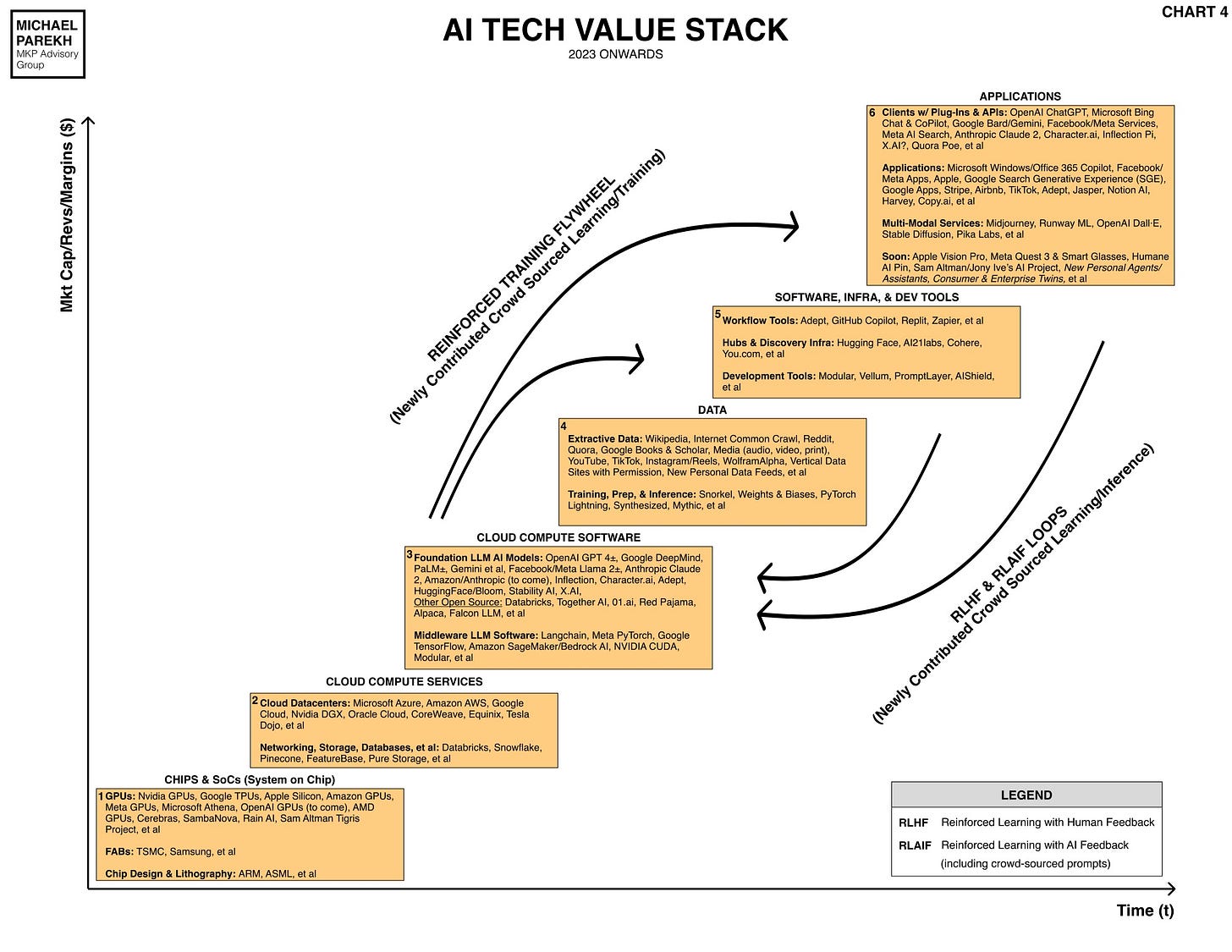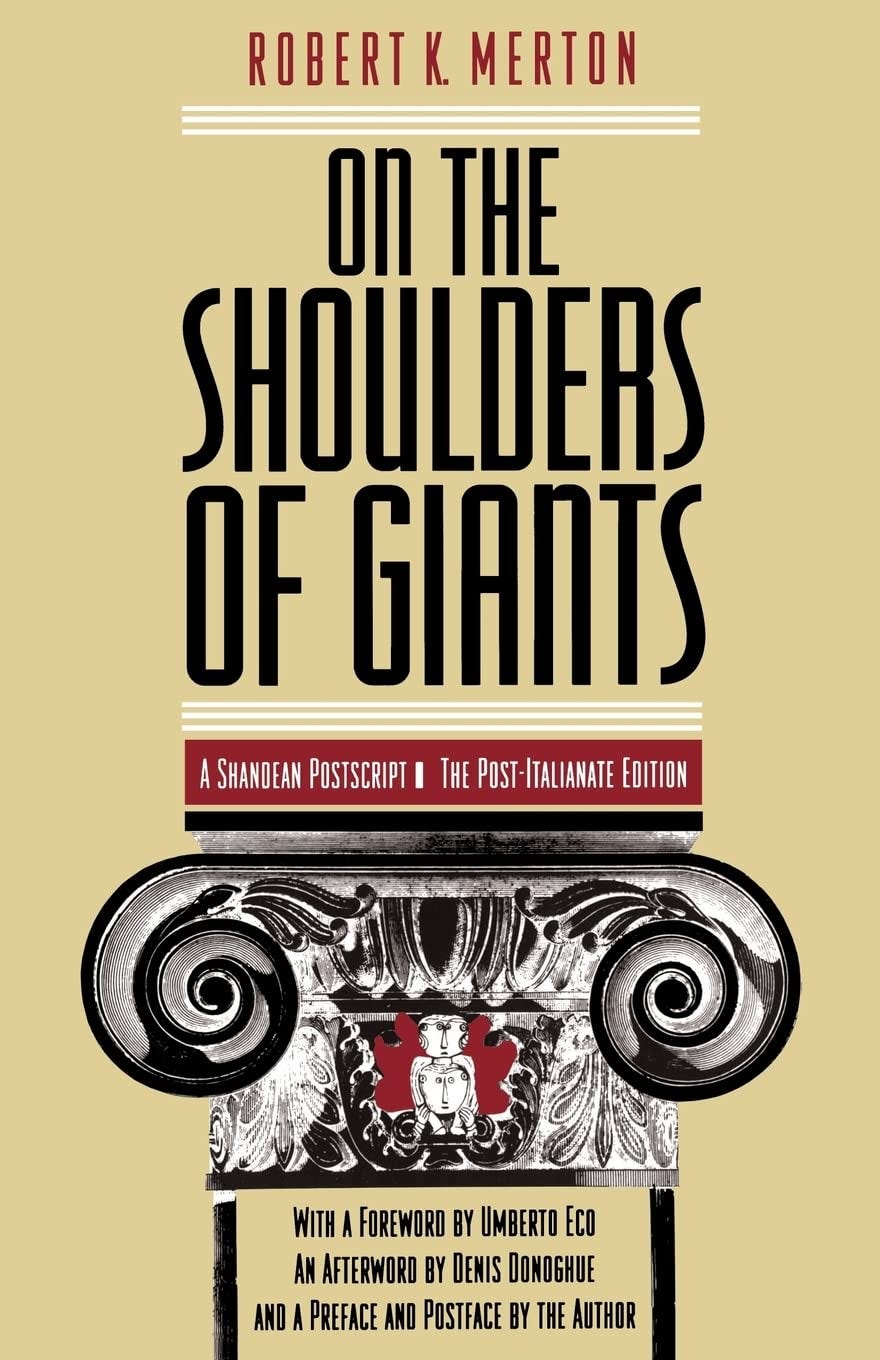AI: On the Shoulders of Giants, Go-Getter 'Creators' & Grunts (OTSOG)
...mainstream AI muses for us all building on our data
The New York Times sued OpenAI and Microsoft this week to stake their claim on the Foundation LLM AI empires being built in these early days of the AI Tech Wave. It’s a continuation of a series of these legal claims by many other publishers, and something I’ve written about at length this year. It will continue as we all become daily users of ChatGPT, Copilot, Google Bard/Gemini AI driven Search, and other AI products and services being rolled out into 2024.
All of these and many, many more that have the potential to improve billions of lives, and brought us to this point in 2023 at the beginning of the AI Tech Wave.
Over the last year of course it’s been text prompts into ChatGPT that have given us tantalizing glimpse of what might happen when computer hardware and software processes ever increasing digital output on the internet as ‘data inputs’ driven by probability based algorithms rather than deterministic algorithms. Then turbo-charged for better results with ‘reinforcement learning loops’.
All of a sudden computers take on the sheen of ‘intelligence’, ‘reasoning’ and seemingly ‘emotional’ capabilities to interact with us in a deceptively ‘human’ way. When they’re just calculating stuff for us in a different but powerful way.
I’ve written about the dangers of anthropomorphizing AI too early, and to imbue it with adjectives like ‘super intelligence’ prematurely. It gives vested parties opportunities to exploit our fears building on the best science fiction based books and movies. And warps our understanding of why what’s going on it both relatively banal and uniquely innovative at the same time.
It’s innovative because AI technologies are finally turbo-charging what humans have done since we evolved from apes. Continually build on the communal creativity of giants and grunts who came before us.
As I’ve written before, some of our best and brightest like Sir Isaac Newton gave it the memorable acronym of OTSOG, better known as “On the Shoulders of Giants”:
“If I have seen further [than others], it is by standing on the shoulders of giants”.
As I wrote in a post on “AI being a timely ‘OTSOG’ antidote for the AI tech fears of our time”:
“Indeed, in my view, it’s ironically appropriate that today’s LLM AI and Generative AI does its current ‘magic’ with ‘reinforcement loops’, flywheels, and all on the Shoulders of all the counted and uncounted Giants, Go-getters and Grunts that have toiled to date, and the digital data of their toils now being extracted for the benefit to augment humans exponentially going forward. It should indeed be called ‘Augmented Intelligence’ and not ‘Artificial Intelligence’, given these OTSOG 2.0 capabilities.”
Suffice it to say that Foundation LLM AI models and ChatGPT are manifestations of computer software and hardware driven processes of building on ‘OTSOG’. These technologies hoover up all our digital data, and offer us answers to our questions in seemingly magical ways. Based on probabilities of the best answers that emerge from what we have all collectively seen and said before. That is what then evokes in some, a sense of ‘emergent’ intelligent behavior.
It’s not.
It’s using massive amounts of mathematical probabilities calculations using the amazing AI hardware and software in AI GPUs, and Generative AI software by Nvidia, OpenAI, Google and an explosive number of new players to come.
All fueled by hundreds of billions in private and public investments. A movie we’ve seen in other tech cycles before.
As we end 2023, we’re on the cusp of transitioning from text based AI, to ‘multimodal’ AI. It’s a fancy way of saying AI driven by voice, pictures, videos, code, and other forms of digital human output repurposed as new inputs. To create new data inputs that then allow the AI machines to process ever more powerful AI GPUs and software in ‘reinforcement learning loops’ to give us new insights from our own digital data.
By standing on the mounds of data before to provide fresh perspectives powered by user prompts. Becoming a new digital Muse.
Much like a Muse inspires artists and creators:
“As a verb, to muse is to consider something thoughtfully. As a noun, it means a person — especially a woman — who is a source of artistic inspiration.”
“In mythology, the Muses were nine goddesses who symbolized the arts and sciences. Today, a muse is a person who serves as an artist's inspiration. Often filmmakers talk about a certain actor being a muse — meaning the actor inspired a movie. Writers, painters, musicians, and other artists have muses. Muse can also refer to thinking deeply. If you muse about something, you're giving it serious thought. You can't muse in five seconds. People muse on certain ideas for years.”
What was once exclusive to Gods, Artists like Picasso, writers like Hemingway, and so many others, is now going available to mainstream masses. We are going to have our own Muses. Many in fact.
It’s just what technology does so well. Make products and services only affordable to a few, globally accessible to most.
These mainstream ‘AI Muses’ may make their first appearances as prosaic ‘Smart Agents’, ‘AI Companions’, ‘Copilots’ and more. But it’s an opportunity for us all to have beautifully automated AI machinery that provides us a distillation of our digital data, and for us all to stand more ‘On the Shoulders of Giants’. And Go-Getter ‘Creators’ and of course Grunts. Not to mention Generated AI. Note that online ‘Creators’ are already a multi-hundred billion economy, according to Goldman Sachs, about to be transformed again by AI.
(Side-note: My all-time favorite historical book on OTSOG by Robert K. Merton highly recommended. TL;DR, but very worthwhile life-long journey).
And yes, we will have to figure out how to compensate us all for our creations large and small, that are the ‘data fuel’ for AI to do its things. It’s a very important detail that will be negotiated and litigated over well into 2024 and beyond. Likely with multiple trips to the Supreme Court. And similar actions worldwide. Lawyers rejoice.
The good news is that we will also have a plethora of new technologies from companies large and small to help build the ‘compensation systems’ for the ‘data fuel’ across LLM AI platforms of all types. It’s not all going to be dependent on legal agreements arranged by a gaggle of lawyers.
But just as important if not more so, is HOW these AI technologies are harnessed and reshaped to be appealing to us all. Both as creators and consumers. We are far from having figured this out.
Indeed, some of our most celebrated tech personalities are very much focused on this challenge and opportunity. Whether it’s OpenAI’s Sam Altman, and Apple’s former uber-designedr Jony Ive funded by billionaire tech investor and rain-maker Masa Son of Softbank fame, or ex-Apple Engineers created an AI pin under the brand Humane AI. And dozens more to come.
Next year is an early continuation of this journey for us all. The AI UI/UX that will ultimately be as influencing as the Mac OS UI/UX, the Apple iPod for music, the iPhone touch UI for smartphones, the prosaic but brilliant Uber interface to call a taxi car, all remain to be invented and executed at global scale.
After having spent the last three decades professionally around the tables of these inventions and more, I’ve more to say on what may be ahead for AI UI/UX. For now, I want to highlight the importance of OTSOG driven by AI going forward, and how these products and services are becoming the ‘Muse for the masses’.
They’re starting out with humble brand names like ChatGPT, Copilot, Claude, Pi, Poe, and others. And they’re all being marketed as AI products and services in Box # 6 in the chart above, that will augment us at work and play.
All this and more is going on here the early days of this AI Tech Wave. And that’s important to think about this interregnum. Happy Holidays. Stay tuned.
(NOTE: The discussions here are for information purposes only, and not meant as investment advice at any time. Thanks for joining us here)





